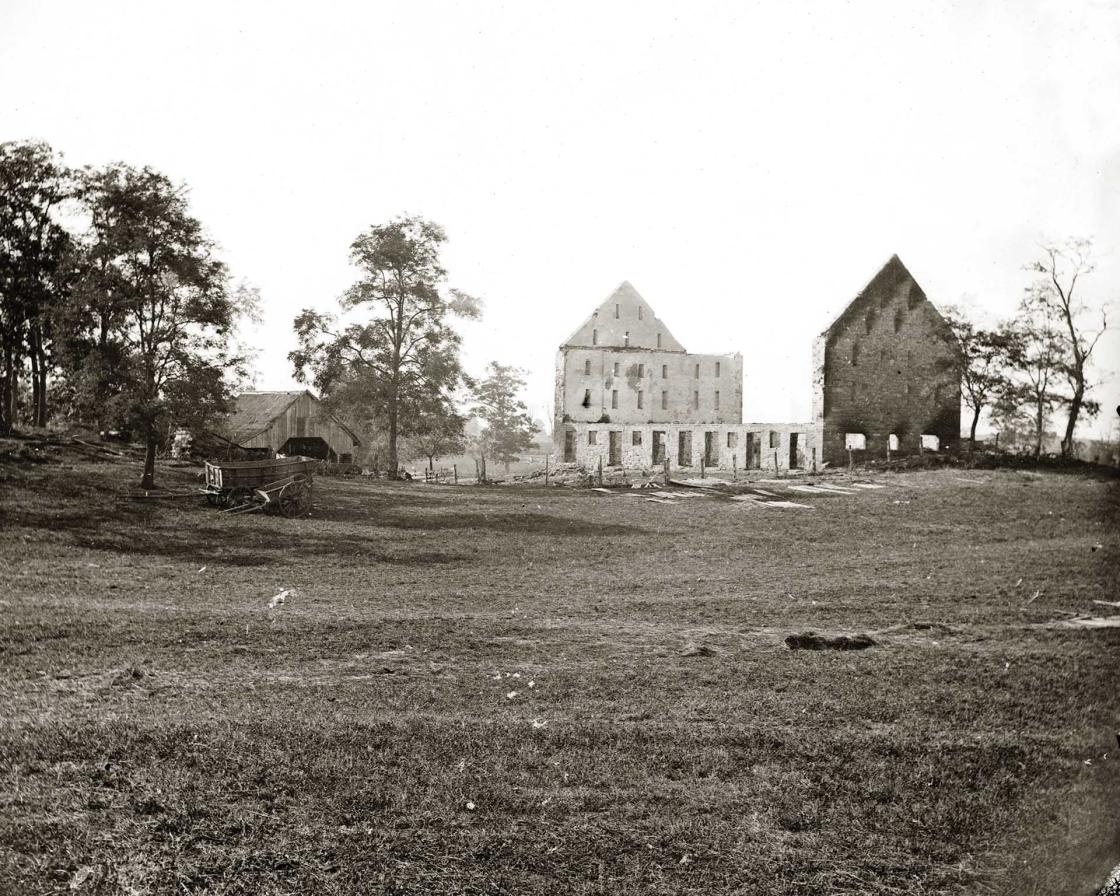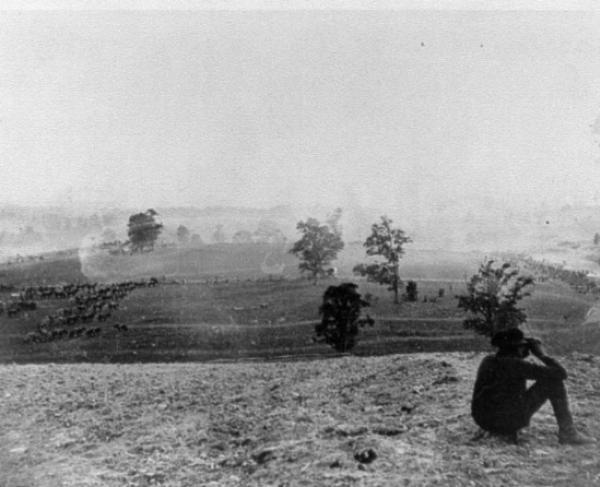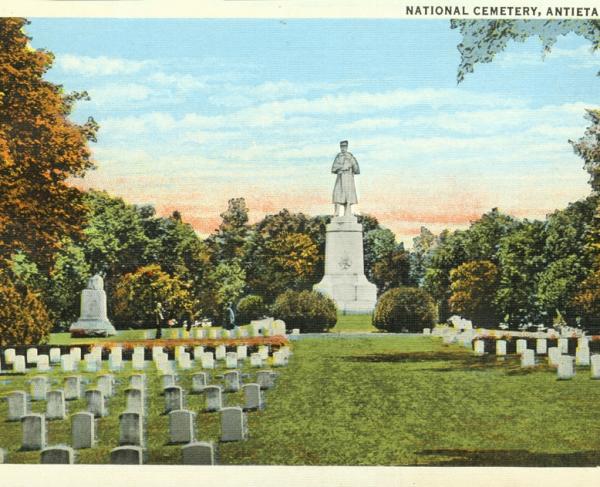
Reel Farm, Antietam Battlefield, Sharpsburg, Md.
As its core mission, the American Battlefield Trust looks to the landscape as a primary source that can teach us about the past in a meaningful way. Occasionally, core battlefield properties contain historic structures that we must also steward and safeguard to ensure they remain in good condition. But a special property at Antietam saw us take on the stories that a set of ruins could tell.
Battle Scars
Around noon on September 17, 1862, what had been a dismal but not uncommonly grisly scene of war became dreadful and incomprehensible…when a barn filled with wounded set ablaze. Located on the battlefield, less than a mile from the infamous sunken road, the barn belonged to David Reel.
In the early 1800s, when, his father, Jacob Reel settled in Sharpsburg, Md., and bought up several hundred acres of farmland to tend and call home to his family, he could not have foreseen the horrors of war those lands would bear witness to on that dreadful day in September 1862.

After Jacob and his wife, Elizabeth, died in 1844 and 1845, respectively, their estate was left to their four children, Henry, Samuel, David and Nancy. Henry received a standalone parcel of 117 acres to the west of Sharpsburg, about a mile from the Reels’ main property, which was divided among the remaining siblings.
Samuel Reel took over a 90-plus-acre parcel north of the family homestead, and David, the eldest brother, the remainder. Nancy and her husband farmed a corner of the land bordering Samuel and David’s farms on what was known as Green Hill.
As Federal and Confederate troops converged on Sharpsburg, the families of Samuel and David Reel and their sister Nancy likely fled to safety at their brother Henry’s home. By 7:30 a.m. on September 17, Rebels from Stonewall Jackson’s division under the command of Gen. John R. Jones had fallen back across the Reel Farm to regroup. David’s barn was used as a first aid station and evacuation site to move Confederate wounded to before transport to hospitals.
Sharpsburg resident and historian John P. Smith was 17 at the time of the battle. He remembered a gruesome scene, “While staying at Mr. Reels I saw a number of wounded and dead Confederates brought into the yard; some were having their limbs amputated, others horribly mangled were dying. One man in particular I shall never forget. His entire abdomen had been torn and mangled with a piece of exploded shell. He uttered piercing and heart rending cries and besought those who stood by for God’s sake to kill him and thus end his sufferings. Death came to his relief in a short time and he was hastily buried in a shallow grave dug in the orchard nearby.”
John Bell Hood’s division withdrew to the farm after fierce fighting in the now-infamous Cornfield and East Woods. At the same time, Confederate reinforcements marched across the Reel farms toward the West Woods and the Sunken Road, while Col. Stephen D. Lee’s artillery battalion redeployed in Reel’s cornfield overlooking the Hagerstown Pike, hoping to repel a Federal advance.
Join Garry Adelman as he "steps in" to Alexander Gardner's famous 1862 photograph of the Confederate dead along the Hagerstown Pike at Antietam.
View...
Writing to early battle historian Ezra Carman in 1898, Capt. Henry W. Addison of the 7th South Carolina Regiment said they were “charging right over the crest of the hill (a green cornfield on our right) where we found the Federals, who had fallen back under it, with innumerable Cannon and numbers of lines of Infantry ready and awaiting us. So rapid was the Federal fire of grape, Canister and Cannon balls of large size together with their Infantry fire, that we lost in Killed and wounded about three fourths of our number in fifteen minutes. I was shot down by a grape shot. In hobbling back to the rear, I crossed back over a brick or stone wall of the Public Road, near where we turned into line of Battle to the Right, to a Barn, I think of brick, where were numbers of our wounded [were]….”
“The fire of the Federal Batteries on this point was terrific after making several futile efforts, in the short intervals of their guns to cool, I finally got off some hundred of yards toward the Town, I looked back, and saw that the Barn or building had been fired, and suppose some of our wounded were burned to death,” Addison wrote.
Sgt. George W. Beale of the 9th Virginia Cavalry later remembered, “A percussion shell from one of the [Federal] batteries, on the sloping hill beyond the Antietam, striking a ledge of rock close by, was exploded, much to our peril and that of the barn, which presently took fire over the wounded men, and to the grim horror of the battle, added those of its flame and smoke.”
The hay-filled barn ignited instantly, burning to the stone foundation.
Restoring the Reel Farm
The American Battlefield Trust purchased the Samuel Reel Farm in 1989 and, in 2000, acquired the bulk of the David Reel Farm, taking ownership of a historic house and barn — built on the foundation of the one that burned in battle. Transforming the present-day barn to the wartime barn’s appearance and utility was a primary goal when the American Battlefield Trust began restoration on the Reel Farm property in 2014.

“The barn was in bad, bad shape,” says Matt George, who spent 11 years as the Trust’s senior manager for land stewardship before retiring this autumn. “It was about 35 percent original and about to collapse.”
The Trust hired a company to evaluate the buildings and create a plan for restoration, but the one-million-dollar price tag was prohibitive. Instead, we purchased the builder’s plans and worked with a preservation-minded, family-owned company that specializes in this very sort of work. The family also opted to lease the land for use as a working farm for five years after restoration.
“We re-planked the entire barn and replaced portions of the roof that needed it,” George says. “The corner of the northeastern wall had to be basically rebuilt because it had collapsed.”
The Trust was able to source stone very similar to the original foundation from a local company, and “today you can hardly tell where they rebuilt the stone corner,” George says. “That’s the best part of this job.”
The house on the Reel Farm property was about 80 percent original but had had very little work done to it since an addition was constructed in the 1920s. Major renovations were required to make it a livable structure. Most of that work was completed by 2020, but some is still ongoing.

Today, a different family rents the full property, using most of the land as pasture for some two dozen cattle and retaining about 80 acres to grow corn and sorghum.
The Reel Farm property is not currently open to the public. While a portion of it lies within the authorized boundary of Antietam National Battlefield, the majority is not, and it would require an act of Congress to adjust that line so the Trust could pursue a transfer to the National Park Service.
Related Battles
12,401
10,316




